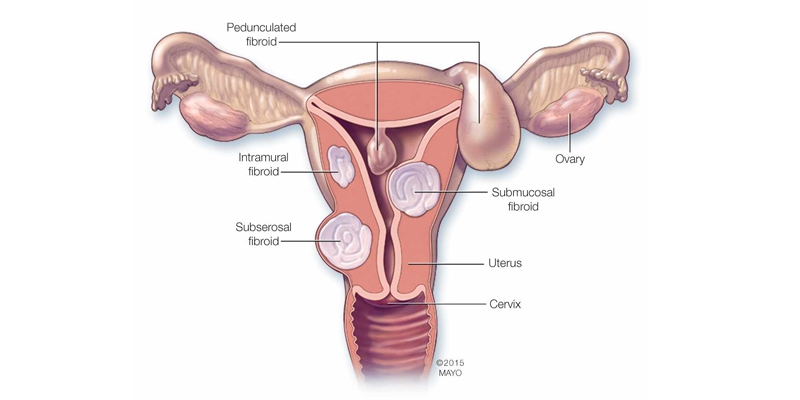Uterine fibroid is the most common benign solid tumor of the female genital tract & is diagnosed in approximately 25-30% of females. The incidence increases in the later years of women's reproductive years.
Uterine Fibroids Symptoms
- Uterine leiomyomas (fibroids) are frequently asymptomatic in which case no treatment is required.
- In other cases, fibroids cause heavy menstrual bleeding with menstrual cramps or both.
- Some women experience difficulty in conceiving.
- Sometimes these fibroids apply pressure on the surrounding organs like bladder and ureter giving rise to difficulty in emptying the bladder or cause backpressure changes leading to hydronephrosis
Diagnosis of Uterine Fibroids
- Haemoglobin - To detect anemia.
- Clinical examination
- Ultrasound pelvis.
Uterine Fibroids Treatment
- Watch the Symptoms -
If the fibroids are small and not giving rise to any symptoms, no active treatment is required. The patient is advised for regular annual ultrasound check up to monitor the size of the fibroid(s).
- Medications -
These can be given to shrink the fibroids temporarily so as to control symptoms such as painful or heavy periods. But, this is not a permanent cure for fibroids.
- Surgery -
This option is offered when the symptoms are not being controlled with medications or in case the fibroids are too big/growing too rapidly.
- Laparoscopic Myomectomy - This is indicated when the female is young and wants to preserve her uterus. Through this keyhole surgery the myoma or the fibroid is removed. This procedure leaves no long scar, so better cosmetic results are obtained. Grade I - No protrusion from anus.
- Total Laparoscopic Hysterectomy - If the women has completed her family & is having multiple fibroids, then the uterus is removed along with the fibroids.
- Hysteroscopic Myomectomy - If the fibroid is encroaching the uterine cavity (i.e submucus in position), then this procedure is opted.
When to see a doctor?
Consult the doctors at Vedanta hospital if you have:
- Difficulty in urinating
- Bleeding or spotting between periods
- Prolonged and overly heavy and painful periods
- Sharp pelvic pain
Causes of Uterine Fibroids -
The exact cause of uterine fibroids is still unidentified, but clinical experience and research states;
- Hormones: progesterone and estrogen are the two hormones responsible for uterine lining development during pregnancy. Fibroids contain excess progesterone and estrogen receptors than a normal uterine tissue cells do. After menopause, the fibroids shrink as the hormone production decreases.
- Genetic Changes : in most cases, the fibroids contain changes in genes.
- Other growth factors: factors like insulin growth may trigger the fibroid growth.
Uterine Fibroids Risk Factors
There are less-known risk factors for uterine fibroids; some of them are
- Heredity : if someone from your family had fibroids like your sister or mother, you are prone to developing them.
- Environmental Factors : use of birth control pills and instruments, the onset of menstruation, vitamin D deficiency, excess alcohol consumption, etc are some environmental risk factors for fibroids.
Complications
Well, uterine fibroids are not considered dangerous, but they can lead to certain complications and cause discomfort like anemia from excessive blood loss.
Hence, it is necessary to consult a doctor the moment you experience any of its symptoms and take the necessary uterine fibroids treatment.
